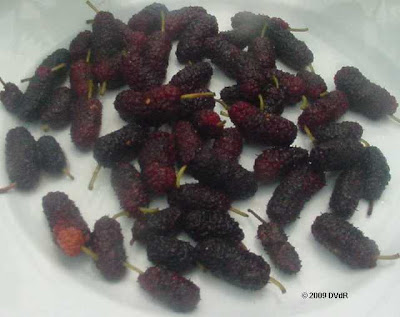 In the fruit garden I am building, I have vacillated over planting a mulberry (malus) because of my zone. Normally mulberries grow in warmer zones, and my area appeared marginal at best.
In the fruit garden I am building, I have vacillated over planting a mulberry (malus) because of my zone. Normally mulberries grow in warmer zones, and my area appeared marginal at best.Then yesterday a neighbor took me to see a wild mulberry tree in the edge of some woods nearby. I managed to pick a handful of berries… just as succulent and sweet as I remember from childhood! The size is about the same length, although not as fat.
Back home to search the ‘net again, I see the ILLINOIS EVERBEARING MULBERRY is said to bear excellent quality reddish-black fruits, and will grow in zones 5-8. (I’m between zone 5 and 6 in a microclimate.) Having tasted mulberries for the first time in more years than I want to admit, I think I’ll take a chance and order a mulberry next spring!
Mulberries are self-fruitful so I only need to order one. If you have never grown mulberries, be warned that they are messy, and dropped fruit will stain anything it touches. The best solution is to find a sunny spot away from the house, walkways and driveway. They are rapid growers and available in several tree forms including weeping; fruit varieties are usually red, white or black.
I will be having sweet dreams of mulberry muffins and ice cream for some time, but my favorite will always be eating mulberries right off the tree, or a dish of them for breakfast with just a tad of citrus juice squeezed over the berries. YUM!!
There's a huge white mulberry tree at the Settler's Museum in Atkins. The trees were issued to farmers in the early 19th century for a potential silkworm market that never materialized. The white mulberries taste like a mild honeydew melon to me. I've never tasted the blue/black mulberries, but I'm told they have a lot more flavor than the white ones.
ReplyDeleteI'll be waiting with my bucket for your new mulberry tree to produce fruit, LOL.